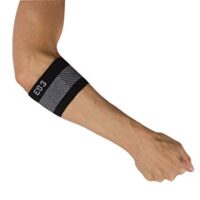Arm Pain

9 Essential FAQ Tips for Alleviating and Managing Arm Pain
Arm pain can cause distress, but implementing several strategies and lifestyle adjustments can help alleviate and manage it. Here are nine frequently asked questions (FAQs) with essential tips for finding relief and improving the health of your arms.
What Causes Arm Pain?
Arm pain can arise from various factors, including muscle strain, tendinopathy, nerve compression, arthritis, injuries, or overuse. These conditions can contribute to discomfort and limited mobility in the arm. To gain a more comprehensive understanding of the common causes of arm pain, please refer to the attached document titled “Common Causes of Arm Pain.” It provides a detailed overview of these conditions. It serves as a valuable resource for identifying and managing arm pain effectively.
When Should I Seek Medical Help?
Knowing when to seek medical help is crucial for your well-being. Promptly contact medical professionals if you experience severe pain that persists or if you have swelling, numbness, or loss of function. Doing so can ensure the attention and care to address your condition effectively.
Remember, seeking medical help in such situations is a proactive step towards safeguarding your health and obtaining the appropriate treatment you may require.
How Can I Relieve Arm Pain at Home?
If you’re looking to find relief for arm pain in the comfort of your own home, there are several approaches you can consider. First and foremost, prioritise rest to allow your arm to recover and heal. Incorporating gentle stretches into your routine can help alleviate muscle tension and improve flexibility. Additionally, you can apply ice or heat therapy to the affected area, alternating between the two to reduce inflammation and soothe discomfort.
However, consulting a healthcare professional before attempting new exercises is always advisable. In some cases, over-the-counter pain medications may provide temporary relief. Still, seeking professional guidance before taking them is crucial to ensure their suitability for your specific situation. By combining these home remedies with professional advice, you can effectively manage and alleviate arm pain.
What are Ergonomic Tips to Prevent Arm Pain?
Incorporating ergonomic practices is essential to prevent arm pain and promote a healthier workspace environment. First and foremost, prioritise maintaining good posture while you work. Ensure that your back is aligned correctly, your shoulders are relaxed, and your arms are at a comfortable height and angle. Additionally, make necessary adjustments to your workspace to optimise ergonomics.
Improvements may involve:
- Adjusting the height of your chair.
- Positioning your keyboard and mouse at a comfortable distance and angle.
- Using an adjustable monitor stand to maintain proper eye level.
Maintain good posture, adjust your workspace ergonomically, and take regular breaks from repetitive tasks. Remember to take frequent breaks from repetitive tasks, allowing your muscles and joints to rest and recover. Consider incorporating stretching exercises or short walks into your break routine to promote blood circulation and alleviate strain. By implementing these ergonomic tips consistently, you can significantly reduce the risk of arm pain and promote overall well-being in your work environment.
Are there Specific Exercises to Strengthen the Arms?
Suppose you’re looking to strengthen your arms through exercise. We highly recommended to seek guidance from professionals such as a physiotherapist or an exercise physiologist.
Their knowledge can provide personalised recommendations and activities tailored to your needs, considering existing conditions or potential injury risks. Consulting with these professionals ensures you engage in appropriate and safe exercises for your current fitness level and goals.
This personalised approach will help you strengthen your arms effectively and minimise the risk of further injury. Remember, the guidance of a professional is invaluable when it comes to designing a well-rounded exercise routine that maximises the benefits while prioritising your safety and well-being.
How Can I Prevent Arm Pain During Exercise or Sports?
To prevent arm pain during exercise or sports:
- Remember to warm up with dynamic stretches before starting and cool down with static stretches afterwards.
- Use appropriate equipment, such as gloves or protective padding, and consider supportive braces or wraps for activities with repetitive arm movements.
- Gradually increase exercise intensity over time to avoid overuse injuries.
- For personalised advice, consult a qualified physiotherapist who can assess your needs and provide tailored recommendations.
Following these strategies and seeking professional guidance will help minimise arm pain, maximise performance, and keep your arms healthy.
Can Alternative Therapies Help with Arm Pain?
Acupuncture, dry needling and massage therapy are alternative therapies that may relieve arm pain. Acupuncture stimulates specific points with needles, promoting pain reduction and circulation. Massage therapy targets tense muscles increases blood flow, and promotes relaxation.
Consult a healthcare professional to determine if these therapies suit your condition and to ensure they complement any medical treatments. Exploring alternative therapies under professional guidance can provide additional options for managing and alleviating arm pain.
What are Self-Care Techniques for Arm Pain?
When it comes to caring for arm pain, incorporating various self-care techniques can be beneficial. Firstly, practising relaxation techniques such as deep breathing exercises, meditation, or mindfulness can help create a sense of calm, alleviate tension, and promote overall well-being. These techniques not only aid in reducing stress but also contribute to relieving arm pain.
Another practical approach to consider is self-massage. By gently massaging the affected area using your hands or a massage tool, you can stimulate blood circulation, release muscle tension, and experience temporary relief from arm pain. Applying appropriate pressure during self-massage and avoiding overexertion is essential, as excessive force can lead to further discomfort.
Topical pain relievers like creams, gels, or ointments can also provide localised relief. These products often contain ingredients such as menthol or capsaicin that help numb the area, reduce inflammation, and alleviate discomfort. It is crucial to follow the instructions on the product carefully. If you have any concerns, consulting with a healthcare professional is recommended.
In some instances, assistive devices like braces or splints can be beneficial. These devices provide support and stability to the affected arm, helping to alleviate strain, promote proper alignment, and reduce the risk of further injury. Consulting with a healthcare professional is essential to determine the appropriateness of using such devices for your condition.
You can actively manage and alleviate arm pain by incorporating these self-care techniques into your routine. Remember to listen to your body, pace yourself, and pay attention to any changes in the pain. If the pain persists or worsens, it is essential to seek medical advice and consult a healthcare professional for a comprehensive evaluation and guidance tailored to your needs.
When Should I Consider Physiotherapy for Arm Pain?
Suppose you are experiencing arm pain that is chronic, recurring, or interfering with your daily activities. In that case, it may be time to consider physiotherapy. Consulting with a physiotherapist can provide personalised treatment options to address your arm pain’s specific causes and symptoms. It is also advisable to consult your physiotherapist or doctor for an accurate diagnosis and to explore tailored treatment options. By taking proactive steps and seeking professional guidance, you can effectively alleviate and manage your arm pain, improving your overall well-being and quality of life.
Rochedale - Call 38410277
Book Online: RochedaleSalisbury - Call 32751044
Book Online: SalisburySandgate - Call 32691122
Book Online: SandgateArticle by John Miller
What Causes Arm Pain?


Arm pain can arise from various factors, including sports injuries, work-related incidents, and repetitive overuse. Understanding the underlying cause is crucial for effective treatment. The causes of arm pain can be broadly categorised by region and structure, such as neck pain, shoulder pain, elbow pain, wrist pain, hand pain, arthritis, bursitis, ligament injury, muscle pain, tendinopathy, and more. It can stem from a local injury, musculoskeletal issue, or even referred from nerves in your neck.
Common Causes of Arm Pain
Shoulder Pain
Common shoulder issues include rotator cuff injuries or frozen shoulder. These conditions often result in significant discomfort and restricted movement. Shoulder pain can severely impact your daily activities, making it difficult to perform simple tasks.
Elbow Pain
Elbow pain is frequently caused by conditions such as tennis elbow or golfer’s elbow. These conditions are typically due to repetitive motions and overuse, leading to inflammation and pain in the tendons around the elbow joint.
Wrist and Hand Pain
Wrist and hand pain can be associated with carpal tunnel syndrome, wrist arthritis, or de Quervain’s tenosynovitis. These conditions can cause numbness, tingling, and weakness in the hands, affecting your ability to grip objects.
Importance of Professional Assessment and Prompt Treatment
Seeking professional assessment and prompt treatment for arm pain is essential. A skilled health practitioner can provide an accurate diagnosis and tailor a treatment plan to address the specific source of your arm pain. Early intervention can significantly improve outcomes and prevent further complications.
Arm pain, especially on the left side, can sometimes indicate a more serious condition, such as a cardiac issue. Therefore, it is vital to seek immediate medical attention if you experience sudden or severe left-arm pain.
Causes of Arm Pain by Region
Neck Pain
- Cervical Radiculopathy: A condition where a nerve in the neck becomes compressed or irritated, leading to pain radiating down the arm.
- Pinched Nerve: Compression of a nerve in the neck can cause arm pain and numbness.
Shoulder Pain
- Rotator Cuff Injuries: These involve damage to the muscles and tendons that stabilize the shoulder joint.
- Frozen Shoulder: Characterised by stiffness and pain in the shoulder joint, making movement difficult.
Elbow Pain
- Tennis Elbow: Inflammation of the tendons on the outer side of the elbow.
- Golfer’s Elbow: Inflammation of the tendons on the inner side of the elbow.
Wrist Pain
- Carpal Tunnel Syndrome: Compression of the median nerve within the wrist, leading to pain and numbness in the hand.
- Wrist Arthritis: Degeneration of the joints in the wrist causing pain and stiffness.
Hand Pain
- Finger Sprain: Stretching or tearing of the ligaments in the fingers.
- Hand Arthritis: Inflammation of the joints in the hand, leading to pain and reduced function.
Causes of Arm Pain by Structure
Arthritis
Arthritis is inflammation of the joints, causing pain and stiffness.
Bursitis
Bursitis is inflammation of the bursa, a fluid-filled sac that reduces friction between tissues.
Ligament Injury
Injury to the ligaments, which connect bones and provide stability to joints.
Muscle Pain
Pain originating from muscles due to overuse, strain, or injury.
Tendinopathy
Disorders of the tendons, including tendinitis (inflammation) and tendinosis (degeneration).
What to Do?
If you experience arm pain, it is crucial to seek professional advice from a physiotherapist or doctor. Early diagnosis and treatment can prevent complications and promote a quicker recovery. Physiotherapists can offer various treatments, including manual therapy, exercises, and advice on lifestyle modifications to alleviate pain and improve function.
Conclusion
Arm pain can have many causes, ranging from injuries to underlying health conditions. Seeking professional assessment and treatment is vital to managing pain effectively and preventing further issues. Don't ignore persistent arm pain; consult your physiotherapist or doctor for a tailored treatment plan.
Rochedale - Call 38410277
Book Online: RochedaleSalisbury - Call 32751044
Book Online: SalisburySandgate - Call 32691122
Book Online: SandgateArm Pain FAQs
1. What are the common causes of arm pain? Common causes include shoulder injuries, elbow conditions like tennis elbow, and wrist issues such as carpal tunnel syndrome.
2. When should I see a physiotherapist for arm pain? Seek professional help if you experience persistent or severe arm pain, especially if it affects your daily activities.
3. Can arm pain be a sign of a serious condition? Yes, left-arm pain can sometimes indicate a cardiac issue. Seek immediate medical attention if you experience sudden or severe left-arm pain.
4. How is arm pain diagnosed? A physiotherapist will assess your symptoms, medical history, and may perform physical tests to diagnose the cause of your arm pain.
5. What treatments are available for arm pain? Treatments can include manual therapy, exercises, and advice on modifications to daily activities to reduce pain and improve function.
6. Can lifestyle changes help reduce arm pain? Yes, modifying activities that strain the arm, using ergonomic tools, and incorporating regular exercise can help manage and reduce arm pain.
Related Articles
- Shoulder Pain: Causes and Treatments - Explore various causes and treatments for shoulder pain.
- Tennis Elbow: Symptoms and Management - Learn about symptoms and effective management strategies for tennis elbow.
- Carpal Tunnel Syndrome: Diagnosis and Therapy - Discover how carpal tunnel syndrome is diagnosed and treated.
- Frozen Shoulder: Understanding and Treatment Options - Find out more about frozen shoulder and its treatment.
- Cervical Radiculopathy: Causes and Relief - Understand the causes of cervical radiculopathy and relief options.
- Wrist Arthritis: Symptoms and Solutions - Learn about the symptoms and solutions for wrist arthritis.
- Rotator Cuff Injuries: Prevention and Care - Explore prevention and care strategies for rotator cuff injuries.
- Golfer’s Elbow: Recognising and Managing - Understand how to recognise and manage golfer’s elbow.
- Thoracic Outlet Syndrome: Symptoms and Treatment - Discover symptoms and treatment options for thoracic outlet syndrome.
- Hand Arthritis: Managing Pain and Stiffness - Find out how to manage pain and stiffness caused by hand arthritis.
- Causes of Arm Pain - WebMD discusses various causes of arm pain and when to seek medical attention.
- Arm Pain: Causes, Diagnosis, and Treatment - Healthline provides a comprehensive overview of arm pain, including causes and treatment options.
- Arm Pain: When to See a Doctor - Mayo Clinic explains when arm pain might indicate a more serious condition and when to seek medical care.
Elbow Pain Causes, Diagnosis, and Effective Physiotherapy Management
Introduction
Elbow pain, a common ailment affecting people of all ages, can disrupt daily activities and diminish quality of life. This article, informed by physiotherapist insights, explores the various causes of elbow pain, emphasising the importance of early diagnosis, accurate assessment, and tailored physiotherapy interventions.
Understanding Elbow Pain
Elbow pain can stem from various sources, ranging from tendinopathy to nerve compression. Identifying the root cause is key to selecting the most effective treatment.


Common Elbow Pain Causes
Tennis Elbow and Golfer's Elbow:
Tennis Elbow and Golfer's Elbow, caused by overuse or strain of the elbow tendons, are prevalent among athletes and those engaging in repetitive arm movements. More info: Tennis Elbow, Golfer Elbow.
Olecranon Bursitis:
Olecranon Bursitis is inflammation of the bursa near the elbow joint leads to pain and swelling.
Youth Elbow Pain:
Conditions like Thrower's Elbow and Little League Elbow are common in young athletes due to repetitive stress. More info: Youth Arm Pain
Neck-Related Arm Pain:
Issues in the neck, like Cervical Radiculopathy or Neck Arm Syndrome can manifest as elbow pain.
Muscle-Related Pain:
Muscle strains and repetitive strain injuries (RSI) often present as elbow discomfort.
Medical Conditions:
Stress fractures, fibromyalgia, and various types of arthritis can also lead to elbow pain.
Recent Research Insights
Recent studies highlight the effectiveness of targeted physiotherapy in treating elbow pain. Techniques such as manual therapy, specific exercises, and other therapies have shown promising results in reducing pain and improving function.
The Role of Physiotherapy in Treating Elbow Pain
Physiotherapy plays a crucial role in the management of elbow pain, focusing on alleviating discomfort and restoring normal function.
Key Physiotherapy Interventions
- Personalised Exercise Programs: Tailored exercises to strengthen and stretch the affected muscles.
- Manual Therapy: Hands-on techniques to improve joint mobility and reduce pain.
- Pain Management: Use of modalities like ice, heat, and ultrasound to manage pain and inflammation.
- Education and Advice: Guidance on activity modification and ergonomics to prevent recurrence.
The Importance of Early Intervention
Early physiotherapy intervention can prevent the progression of symptoms and facilitate a quicker return to daily activities.
When to Seek Professional Advice
Consult a physiotherapist or doctor if you experience persistent or worsening elbow pain. They can conduct a comprehensive assessment and develop a personalised treatment plan.
What to Do?
If you're experiencing elbow pain:
- Rest: Avoid activities that exacerbate the pain.
- Apply Ice: To reduce swelling and pain.
- Seek Professional Help: A physiotherapist can provide expert advice and treatment.
Conclusion
Elbow pain, though common, can be effectively managed with physiotherapy. Understanding the cause, seeking early treatment, and adhering to a personalised care plan are vital for a successful recovery.
For more detailed information on elbow pain causes and treatments, visit PhysioWorks, where you can find resources and professional advice tailored to your condition.





























































